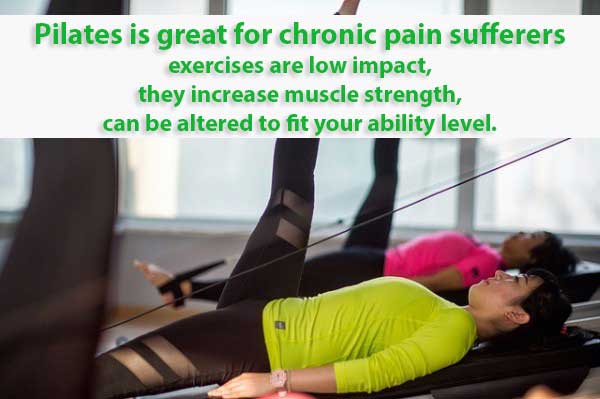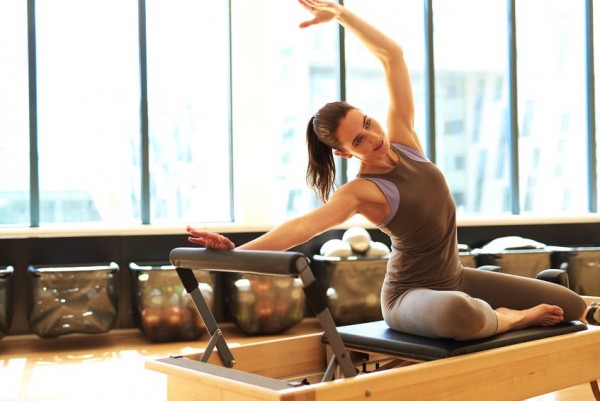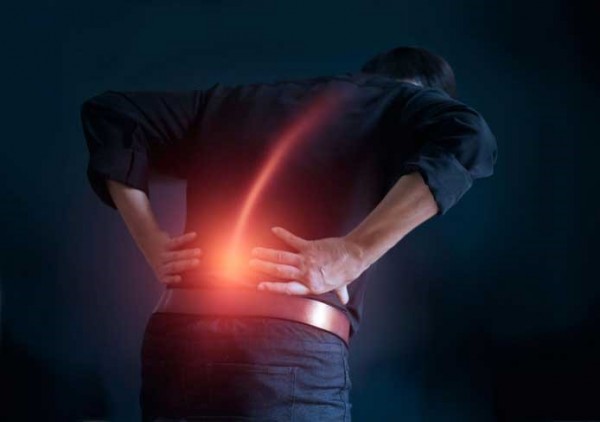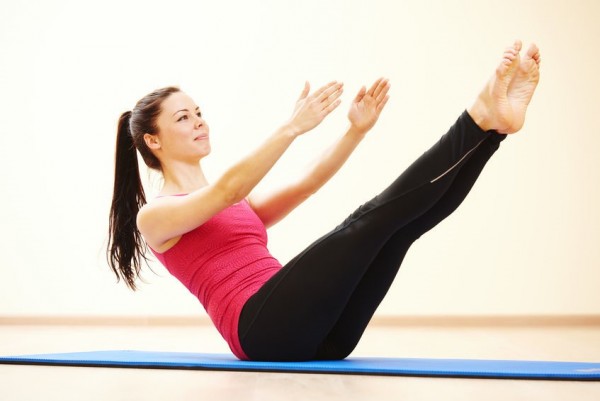Pilates for Chronic Pain

What is Pilates?
Pilates is a method of exercise and physical movement designed to stretch, strengthen, and balance the body (7. An Exercise in Balance: The Pilates Phenomenon). It will stabilize and strengthen your core postural muscles supporting the spine. Pilates helps with alignment which helps relieve and prevent back pain. When doing Pilates, you gain greater control over the movement of your body through correct spinal and pelvic alignment, concentration on movement, and proper breathing.
Benefits of Pilates Over Other Strength Building Exercises
Traditional workouts that are weight-bearing often build short, bulky muscles which are easier to injure. Through Pilates, your body becomes more flexible and your strength is balanced. It elongates and strengthens the body improving muscle elasticity and joint mobility. Also, many traditional workouts emphasize one muscle group over another, so your body’s muscles often become unbalanced. Weak muscles get weaker and strong muscles to get stronger. Pilates strengthens the whole body evenly from your neck all the way down to your ankles and feet. No muscle group is overworked or underworked. Because of these benefits, Pilates is a popular exercise for professional sports teams, athletes, and even physical rehabilitation centers.
Benefits of Pilates for Chronic Pain

Pilates exercises for chronic pain work by enhancing the primary muscular support system of the body, to offload the joints and important structures of the body, ultimately leading to a reduction of pain (3. Physiolates, 2018). Pilates is great for chronic pain sufferers because exercises are low impact, increase muscle strength, and can be altered to fit your ability level. Often your brain will move away from focusing on painful areas when it is busy concentrating on the body as a whole.
Benefits Include:
- Reduced or eliminated pain
- Great for injury recovery
- Increasing control over pain
- Create more efficient patterns of movement
- Better posture
- Less risk of injury
- Improved function making daily activities easier
- Greater feeling of well-being
- Increased confidence and independence
- Reduced muscle stiffness
- Improving joint mobility
- Increases flexibility
- Promote weight loss
12 Scientifically Proven Reasons Pilates Leads to Peace of Mind
(Pilates Bridge connecting the Pilates community)
- Improves memory: The part of our brains responsible for cognitive function and memory start shrinking in our late 20’s. Recent studies show that exercise improves the creation of new brain cells and protects existing cells. Another study shows that people who practice mindful activities such as yoga or Pilates experience superior brain function.
- Trains your brain: Learning a new Pilates routine will help challenge the body and mind.
- Deeper muscle activation means the better function of the nervous system: We use specific areas of the brain every time we move.
- Calm mind and emotions with Pilates: Pilates has a lot of the benefits of mindfulness meditation which include a calmer mind.
- Relieves stress tension in your body: Through releasing tension in your muscles, stress hormones are reduced. By removing stress from the body, you also get it out of your mind.
- Tames your stress: It can also prevent stress, due to the mindfulness aspect.
- Makes you happier: When the body is positively stressed it releases endorphins that make us feel good.
- Makes you more creative: Mindfulness meditation is known to improve creativity.
- It lets you control your emotions: The breathing techniques you learn can help calm your mind in stressful situations.
- Mindful Movement helps release emotional tension: You learn to gain control over the deep core muscles closely connected to emotional baggage.
- Teaches you to be yourself: With Pilates your progress is based on personal standards and priorities, you are not in competition with anyone else.
- Become more confident: Confidence can be gained from having good posture.
How Safe is Pilates for Chronic Pain?
 Many of the exercises require reclining or sitting positions. They are also low-impact exercises that are only partial weight-bearing. This is not a cardio workout. When doing Pilates, the focus is on the way the body moves, it is not about the number of repetitions, and you don’t want to over-stress your muscles. It’s not an exercise that is known to make you sweat, because it’s all about concentration and breathing. The exercises are pretty safe considering many physical therapy facilities use Pilates to rehabilitate after injuries.
Many of the exercises require reclining or sitting positions. They are also low-impact exercises that are only partial weight-bearing. This is not a cardio workout. When doing Pilates, the focus is on the way the body moves, it is not about the number of repetitions, and you don’t want to over-stress your muscles. It’s not an exercise that is known to make you sweat, because it’s all about concentration and breathing. The exercises are pretty safe considering many physical therapy facilities use Pilates to rehabilitate after injuries.
What Conditions does Pilates help with?
Conditions Pilates Helps with Include:
- Chronic back pain: View Exercises
- Fibromyalgia: View Exercises
- Post-surgery
- Postural pain
- Whiplash
- Shoulder pain
- Hip pain
- Arthritis
- Multiple Sclerosis: View Exercises
Chronic Low Back Pain
Pilates can help with chronic low back pain because it strengthens your weak core muscles that often create pain. Pilates is so effective with chronic back pain that it is considered one of the best choices of therapy for people with back pain. Just make sure you check with a doctor and use a Pilates instructor with plenty of experience helping people with low back pain.
Arthritis
Many people with arthritis are afraid to exercise because they are concerned about intensity. However, Pilates exercises are low-impact, gentle movements, that are purposeful, preventing stress on joints.
 Fibromyalgia
Fibromyalgia
Pilates is also an excellent exercise for people with fibromyalgia. Not only is it great for stability and a low-impact exercise, but also for breathing. Pilates emphasizes breathing techniques to relax muscles and prevent tension. Breathing oxygenates the blood and increases circulation to all regions of the body (4. balanced body). Oftentimes people with fibromyalgia tend to disconnect from their bodies. Pilates is all about the connection of the mind and body. It also helps to prevent hypermobility and reduces fatigue symptoms associated with fibromyalgia.
Find out how Pilates helped Stuart, a 54-year-old male diagnosed with both fibromyalgia and osteoarthritis. He has been able to stretch and strengthen muscles without pain and improve his mood and overall well-being.
People with heart disease, high blood pressure, high cholesterol, or diabetes can participate in Pilates, as well. However, it is recommended to check with your doctor first.
 Tips for Doing Pilates Exercises with Chronic Pain
Tips for Doing Pilates Exercises with Chronic Pain
- Try to do Pilates right away in the morning this could help to push back fatigue.
- Keep repetitions to a minimum, muscles must be comfortable throughout all exercises. Pilates doesn’t work like other strength exercises that require you to push yourself till your muscles go weak.
- Speed of movement can be cut in half for exercises to prevent muscles from any discomfort.
- To get the most out of Pilates it is best to have a personalized program from an instructor when dealing with chronic pain. For some conditions mat work may be too challenging.
- Simplify and modify exercises that are too challenging.
- Be patient, gains in muscle strength will be slow and you could experience a setback at some point. Even if your pain level remains the same for a while, you will still gain strength which will benefit your health overall.
How to Get Started with Pilates?
Pilates can be done in the comfort of your own home with just an exercise mat. You can use videos you find online or purchase a DVD. Otherwise, you can go to a gym or studio that has special Pilates equipment and work with a trainer or take part in a class. If you can do a class or utilize a trainer, it will be beneficial because a lot of the moves require a ton of precision and control. The technique is everything when it comes to Pilates.
Pilates classes are usually 45 minutes to an hour, but you can do fewer moves in less time. Pilates exercises are typically done in a specific order. Pilates just like strength training should be done a few days a week in addition to cardio exercise. There is a ton of great Pilates exercises for beginners, and modifications that can be made if exercises are too painful to do.
Finding a Good Pilates Instructor
Instructors don’t have to be licensed in order to teach Pilates. Through the Pilates Method Alliance, there is a Pilates Certification Exam to ensure teachers are competent and safe to teach Pilates to the public. It is the only independent measure of Pilates teaching competency available today and has no commercial relationship to any teacher training program (7. Pilates Method Alliance). So make sure you find out about the experience or certifications for Pilates instructors or find a good referral. You can search for a Pilates instructor on the Pilates Method Alliance website.
History of Pilates
Pilates was invented by Joseph Hubertus Pilates. Joe started studying different exercises and athletics to help with his asthma and other ailments. By age 14 he had such a well-sculpted body that he was posing for anatomical charts. Eventually, his involvement in multiple sports (skiing, diving, gymnastics, and boxing) helped him to overcome his ailments. Joe was fascinated by the classical Greek ideal of a man balanced in body, mind, and spirit. He created Pilates with this idea in mind. He also studied yoga, martial arts, bodybuilding, recreational sports, and even the way animals stretch, to be incorporated into his exercises that eventually became Pilates.
In 1912 he went to England to be a self-defense instructor for detectives at Scotland Yard. When World War I broke out he interned as an “enemy alien” with other German nationals. Joe then developed his exercises rigging springs to hospital beds providing resistance exercises for patients. These innovations eventually led to his equipment designs. In 1918 when an influenza outbreak occurred in England thousands of people died. However, none of Joe’s trainees died.
Joe emigrated to the United States in 1926. During his travels, he met his wife Clara Zeuner and they opened a studio together in New York. Many of Joe’s clients consisted of dancers including the New York City ballet. By 1964, Joe’s well-trained students began to teach Pilates outside of New York and classes spread across the United States. He continued to train clients up until 1967 when he died and left no line of succession for Pilates to carry on. However, his exercises still grew in popularity due to his protégés.
Resources:
1. Robinson, Kara Mayer. (2017, April 26th) WebMD/Pilates. Retrieved from: https://www.webmd.com/fitness-exercise/a-z/what-is-pilates
2. Wingrove, Jennifer Curry. (2015, Sept. 18th) IDEA Health & Fitness Association/Pilates for Osteoarthritis. Retrieved from: http://www.ideafit.com/fitness-library/pilates-for-chronic-pain-and-osteoarthritis
3. Physiolates/Pilates for Chronic Pain. Retrieved from: http://physiolates.org.uk/types-of-pilates/clinical/chronic-pain.php
4. Shirer, Gabrielle. balanced body/Pilates for Fibromyalgia/Pilates Origins/The Benefits of Pilates. Retrieved from:
https://www.pilates.com/BBAPP/V/pilates/library/articles/pilates-for-fibromyalgia.html
5. Kullhem, Ian. (2015, May 14th) Pilates in the Pines/Pilates and Chronic Pain. Retrieved from:
http://pilatesinthepines.com/?/our-news/article/pilates-and-chronic-pain
6. Pilates Bridge connecting the Pilates community/12 Scientifically Proven Benefits of Pilates for Your Peace of Mind. Retrieved from:
http://pilatesbridge.com/12-scientifically-proven-benefits-of-pilates-for-your-peace-of-mind/
7. Pilates Method Alliance (PMA)/An Exercise in Balance: The Pilates Phenomenon. Retrieved from:
https://www.pilatesmethodalliance.org/i4a/pages/index.cfm?pageid=3277/
